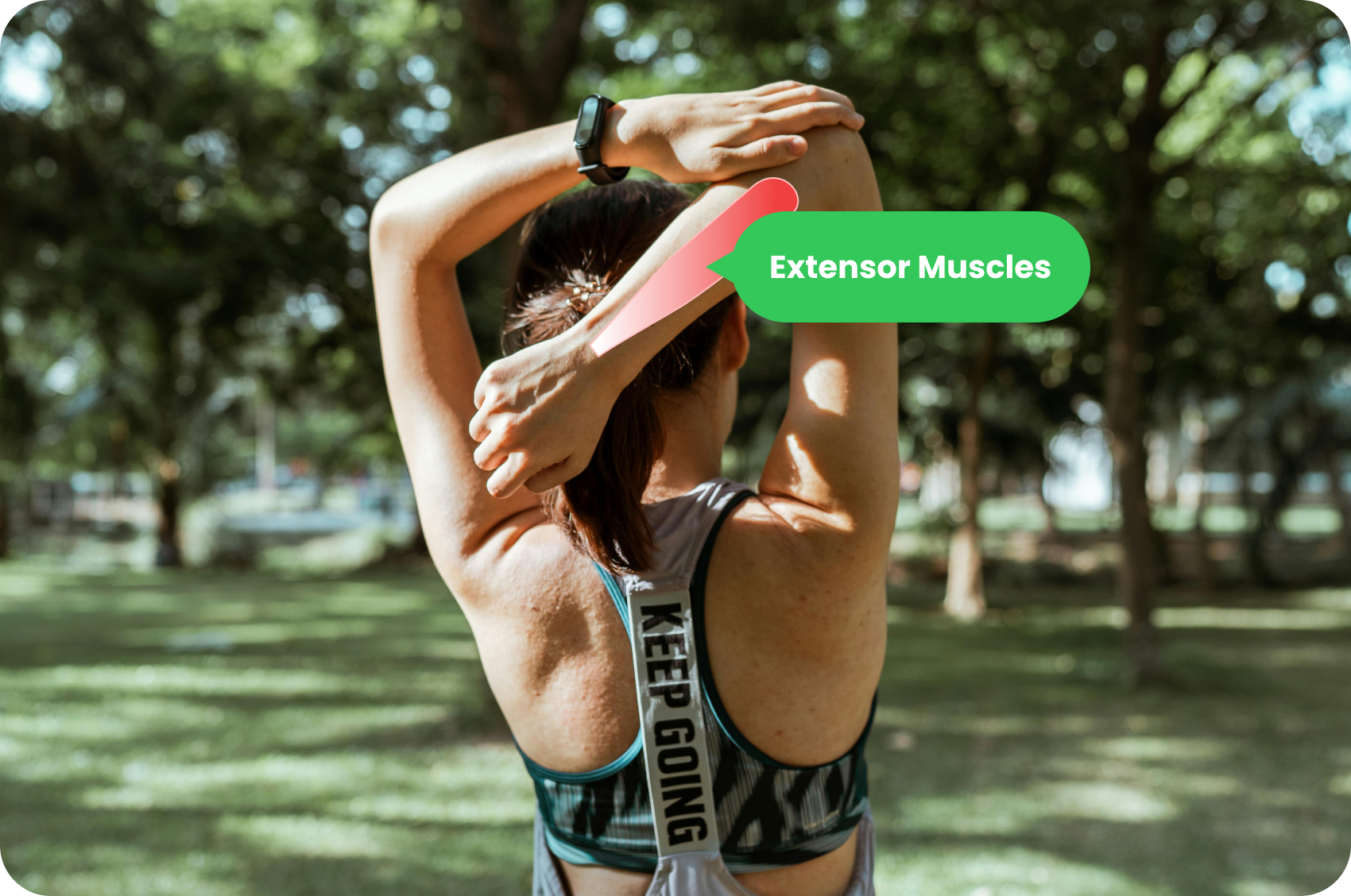Imagine you’re cycling or typing away at your computer when suddenly a sharp pain shoots through your forearm.
It catches you off guard, making you wince and pause for a moment.
This pain might feel like a dull ache that lingers, a sharp stab when you move, or a persistent throb that refuses to go away.
It can make everyday tasks like opening a jar, carrying groceries, or even just holding your phone surprisingly difficult and frustrating.
Have you ever experienced forearm pain?
What should you do when the forearm injury strikes?
In this article, we will explore the nature of forearm pain, understand its causes, and discover effective ways to treat it.
Anatomy of the Forearm
Let’s dive into the anatomy of the forearm. We promise we won’t get you bored.
The forearm is made up of two main groups of muscles: flexors and extensors.
Flexor Muscles
These muscles are located on the inner side of your forearm.
They help you bend your wrists and fingers.
When you make a fist, write with a pen, or grip a doorknob, you’re using your flexor muscles.

Extensor Muscles
These muscles are found on the outer side of your forearm.
They allow you to straighten your wrist and fingers.
When you open your hand, lift something with your palm facing down, or wave goodbye, your extensor muscles are at work.

Flexor and extensor muscles play a crucial role in many of our daily activities.
Whether you’re typing on a keyboard, lifting a coffee cup, or playing a sport, your forearm muscles are constantly in use.
Understanding their function helps us appreciate their importance and why caring for them is essential to avoid pain and maintain our day-to-day functionality.
Now, let’s move on to the common reasons for forearm pain.
Common Causes of Forearm Muscle Pain
Forearm injury can happen from several different causes.
Here, we explore some of the most common things that trigger forearm pain.
Overuse Injuries (Repetitive Strain Injury)
When you repeat the same motion over and over, like typing on a keyboard, playing a musical instrument, or using tools, it can strain your forearm muscles.
This repetitive strain can lead to pain and discomfort over time.
Acute Injuries (Sprains, Strains)
These occur suddenly, usually from a specific incident like falling and catching yourself with your hand, lifting something too heavy, or twisting your arm awkwardly.
Sprains involve ligaments, while strains involve muscles and tendons.
Medical Conditions (Tendinitis, Carpal Tunnel Syndrome)
Tendinitis is inflammation of the tendons in your forearm, often caused by overuse.
Carpal tunnel syndrome is a condition where a nerve in your wrist gets compressed, causing pain, numbness, and tingling that can extend into your forearm.
Poor Ergonomics and Posture
Using a computer or phone for long periods without proper support or having poor posture while working can strain your forearm muscles.
This strain can lead to pain and discomfort over time.
Understanding these common causes can help you identify why you might be experiencing forearm pain and take steps to address it.
What are the Symptoms of Forearm Injuries?
Forearm pain can manifest in several ways.
Here are some common symptoms to watch out for.
Pain and Tenderness
You might feel a constant ache or sharp pain in your forearm. This chronic pain becomes unbearable.
The area could be tender to the touch, making it uncomfortable to press on or massage.
Swelling and Inflammation
Your forearm might appear swollen or puffy, and the skin may feel warm to the touch. Inflammation is the body’s response to injury or overuse.
Weakness in the Forearm
You may notice a decrease in strength, making it difficult to grip objects, carry groceries, or perform other tasks that require forearm strength.
Limited Range of Motion
Moving your wrist or fingers might become challenging or painful.
You could experience stiffness, making it hard to perform activities that require a full range of motion, such as typing or lifting.
If you recognize some of these symptoms early, it is time to seek appropriate treatment and prevent further complications.
Have any of these symptoms?
Here is what you should do then.
Forearm Pain Diagnosis
Imagine waking up one morning with a nagging pain in your forearm that refuses to go away.
You try to ignore it, but the discomfort persists, making it difficult to go about your daily activities.
Whether you’re typing at your desk, lifting your morning coffee, or simply turning a doorknob, the pain is a constant reminder that something isn’t quite right.
Understanding the source of this forearm pain is crucial for finding relief and getting back to your normal routine.
Identifying the cause of forearm pain typically involves several steps.
Physical Examination
First, you should see your doctor.
A healthcare provider will start by examining your forearm.
They will check for tenderness, swelling, and any areas of pain.
They might ask you to move your wrist, fingers, and elbow joint to assess your range of motion and pinpoint the source of discomfort.
Medical History
Your doctor will ask about your medical history, including any recent injuries, repetitive activities, or underlying health conditions that might contribute to your forearm pain.
This information helps in identifying potential causes and determining the best course of action.
Imaging Tests (X-rays, MRI)
If the physical examination and medical history don’t provide a clear diagnosis, imaging tests like X-rays or MRI scans may be ordered.
X-rays can help detect forearm bones fractures or arthritis.
MRI scans provide detailed images of soft tissues, including muscles, tendons, and ligaments, to identify issues like tendinitis or muscle tears.
These diagnostic steps are crucial for accurately identifying the cause of your forearm pain, which in turn allows for effective treatment and management.
How to Treat Forearm Pain
Treating forearm pain involves a combination of approaches. Here are some effective options:
Rest and Activity Modification
Giving your forearm muscles time to heal is crucial.
Avoid activities that worthen the pain, like typing for long periods or lifting heavy objects.
If your job or workout routine requires repetitive motions, try to take frequent breaks and switch to less strenuous tasks when possible.
Resting allows the muscles to recover and reduces inflammation.
Ice and Heat Therapy
You can also try to apply ice packs to the affected area. This can help reduce swelling and numb the pain.
Ice should be used for the first 48 hours after an injury.
After the initial period, heat therapy, such as warm compresses or heating pads, can relax and soothe tight muscles.
Alternating between ice and heat can also be beneficial.
Pain Relief Medications
Over-the-counter pain relievers can help manage pain and reduce inflammation.
Be sure to follow the dosage instructions and consult your doctor if you have any medical conditions that might be affected by these medications.
Physical Therapy Exercises
Specific exercises can strengthen the muscles and improve flexibility.
A physical therapist can design a personalized exercise plan that targets the affected muscles.
Examples include gentle stretching, wrist flexor and extensor exercises, and resistance band workouts.
These exercises help restore function and prevent future injuries.
Ergonomic Adjustments
Making changes to your workspace can prevent further strain on your forearm muscles.
For instance, if you work at a computer, ensure your desk and chair are at the proper height to maintain good posture.
Use ergonomic keyboards and mice to reduce strain.
Additionally, consider using wrist supports or splints to keep your wrists in a neutral position during activities.
These treatment options can significantly reduce forearm muscle pain and help you return to your daily activities comfortably.
Always consult with a healthcare professional to determine the best treatment plan for your specific condition.

Top 5 Exercises for Forearm Pain Prevention
For sports that require a strong grip, like cycling, it’s important to condition your arms, especially your forearms.
Strengthening and stretching your extensor muscles can help prevent muscle pulls from sudden forces or overuse.
Here are a few exercises you can include in your regular workout routine to keep your forearms strong and flexible.
Wrist Flexor Stretch
Extend your arm in front of you with your palm facing up.
Use your other hand to gently pull your fingers back towards your body until you feel a stretch in your forearm.
Hold for 15-30 seconds, then switch arms.
Benefits: This stretch helps improve flexibility in the wrist flexor muscles.

Wrist Extensor Stretch
Extend your arm in front of you with your palm facing down.
Use your other hand to gently pull your fingers back towards your body until you feel a stretch in your forearm.
Benefits: This stretch targets the wrist extensor muscles, improving flexibility, blood flow, and reducing the risk of strain.
Wrist Curls
Sit with your forearm resting on your thigh or a bench, palm facing up, and hold a lightweight or dumbbell.
Slowly curl your wrist up, then lower it back down.
Perform 10-15 repetitions, then switch to the other arm.
Benefits: Wrist curls strengthen the wrist flexor muscles, enhancing grip strength and endurance.
Reverse Wrist Curls
Sit with your forearm resting on your thigh or a bench, palm facing down, and hold a lightweight or dumbbell.
Slowly curl your wrist up, then lower it back down.
Perform 10-15 repetitions, then switch to the other arm.
Benefits: Reverse wrist curls strengthen the wrist extensor muscles, helping to balance muscle development in the forearm.
Plate Pinches
Hold two weight plates together with your thumb on one side and your fingers on the other.
Pinch the plates and hold them for as long as possible. Repeat with the other hand.
Sets/Reps: 3 sets of 30-60 seconds.
Benefits: Strengthens the muscles involved in gripping, improving overall forearm strength.
Try to incorporate these exercises into your gym routine to keep your forearm muscles strong and flexible. It will help you reduce the risk of pain and injury.
Barbell Wrist Curls
Sit on a bench and rest your forearms on your thighs with your palms facing up. Hold a barbell with both hands.
Curl the barbell up by flexing your wrists, then slowly lower it back down.
Sets/Reps: 3 sets of 12-15 repetitions.
Benefits: Strengthens the wrist flexor muscles, enhancing grip strength.

Barbell Reverse Wrist Curls
Sit on a bench and rest your forearms on your thighs with your palms facing down. Hold a barbell with both hands.
Curl the barbell up by extending your wrists, then slowly lower it back down.
Sets/Reps: 3 sets of 12-15 repetitions.
Benefits: Strengthens the wrist extensor muscles, helping to balance muscle development in the forearm.
What are Other Ways to Prevent Forearm Injuries?
Preventing forearm muscle pain is often easier than treating it.
Here are some practical tips to help keep your forearms healthy and pain-free.
Taking Breaks During Repetitive Tasks
If your daily activities involve repetitive motions, like typing, playing an instrument, or using tools, make sure to take regular breaks.
Aim for a short break every 30 minutes to give your muscles a rest.
During these breaks, stretch your forearms and move around to promote circulation and reduce muscle fatigue.
Using Proper Techniques in Sports and Activities
When participating in sports or other physical activities, use proper techniques to avoid putting unnecessary strain on your forearms.
For example, when lifting weights, ensure you’re using the correct form to distribute the load evenly across your muscles.
In racquet sports like tennis, consider working with a coach to refine your technique and reduce the risk of injury.
Implementing these prevention tips can help you maintain healthy forearm muscles and reduce the likelihood of experiencing pain.
Making small adjustments to your daily habits can have a significant impact on your overall well-being.
When to Call a Doctor About Muscle Strain
Let’s say you’re an avid cyclist, and every weekend, you hit the trails with your friends.
It’s your favorite way to unwind and stay fit.
But lately, you’ve noticed a persistent ache in your forearm that doesn’t seem to go away, no matter how much you rest.
You try to shake it off, thinking it’s just temporary, but then you start feeling a strange tingling sensation running from your forearm to your fingers.
Even simple tasks like gripping the handlebars or opening a water bottle become difficult and painful.
If this story sounds familiar, it’s crucial to know when it’s time to seek medical help.
Here are some key signs that you should call a doctor:
Persistent or Worsening Pain
If your forearm pain doesn’t improve with rest and basic treatments, or if it gets worse over time, it’s important to see a doctor.
Persistent pain could indicate an underlying issue that needs professional evaluation and treatment.
Signs of Nerve Compression (Numbness, Tingling)
Experiencing numbness, tingling, or a “pins and needles” sensation in your forearm, hand, or fingers can be a sign of nerve compression, such as carpal tunnel syndrome.
These symptoms should not be ignored, as pinched nerves can lead to more serious complications if left untreated.
Difficulty in Performing Daily Activities
If your forearm pain is interfering with your ability to perform everyday tasks, such as lifting objects, typing, or even holding a cup, it’s time to consult a doctor.
Difficulty in performing routine activities can significantly impact your quality of life and may require medical intervention.
Seeking timely medical advice can help diagnose the underlying cause of your forearm pain and ensure you receive appropriate treatment to alleviate symptoms and prevent further complications.
Wrapping Up
Forearm muscle pain can be a real hindrance in our daily lives, but with the right knowledge and approach, it’s manageable.
Understanding the anatomy of the forearm, recognizing the common causes and symptoms, and knowing when to seek medical help are crucial steps in dealing with this issue.
Implementing preventive measures, such as proper ergonomics, regular exercises, and breaks during repetitive tasks, can go a long way in keeping your forearms healthy and pain-free.
Remember, if your pain persists or worsens, don’t hesitate to consult a healthcare professional for proper diagnosis and treatment.
Stay proactive, and take care of your forearms to continue enjoying your daily activities without discomfort.
Explore elite triathlon training programs
Elevate your performance with comprehensive training programs tailored to your goals.
FAQs
What is the most common cause of forearm muscle pain?
The most common cause of forearm muscle pain is repetitive strain injury. It occurs from repeating the same motion over and over, such as typing, using tools, or playing a musical instrument.
How can I prevent forearm muscle pain when using a computer?
To prevent forearm muscle pain while using a computer, ensure your workspace is ergonomically set up.
Use an ergonomic keyboard and mouse, keep your wrists in a neutral position, and take regular breaks to stretch and move around.
How can I prevent forearm muscle pain when cycling?
To prevent forearm muscle pain when cycling, start by ensuring your bike setup is correct, with handlebars at a comfortable height and padded grips to reduce pressure.
Maintain a relaxed grip and neutral wrist position while riding.
Take regular breaks during long rides to rest your hands and forearms, and periodically shake out your hands to relieve tension.
Incorporate wrist stretches and strengthening exercises into your routine to keep your forearm muscles flexible and strong.
Listen to your body and stop to stretch if you start feeling pain or discomfort.
These simple adjustments can help you ride comfortably and avoid forearm muscle pain. Before and after the ride, do some stretches for cyclists to prevent injuries.
Are there any specific exercises to strengthen my forearm muscles?
Yes, exercises such as wrist curls, reverse wrist curls, wrist flexor and extensor stretches, and grip-strengthening exercises like plate pinches can help strengthen your forearm muscles and prevent pain.
When should I see a doctor for my forearm pain?
You should see a doctor if your forearm pain persists despite rest and basic treatments. If you experience numbness or tingling (signs of nerve compression), or if the pain interferes with your ability to perform daily activities, you also need to see a doctor.
Does forearm pain require surgical treatment?
Forearm pain usually does not require surgical treatment and can often be managed with rest, physical therapy, ergonomic adjustments, and pain relief medications.
However, in severe cases where conservative treatments fail to provide relief, or if there is a significant underlying issue such as nerve compression or severe tendinitis, surgical intervention might be necessary.
It’s important to consult a healthcare professional for an accurate diagnosis and to discuss the best treatment options for your specific condition. Elbow surgery is typically considered a last resort when other treatments have not been effective.
Can forearm muscle pain be a sign of a serious condition?
While forearm muscle pain is often due to overuse or minor injuries, it can sometimes indicate a more serious condition, such as tendinitis or carpal tunnel syndrome.
Persistent or severe symptoms should be evaluated by a healthcare professional to rule out any serious underlying issues.
What is tennis elbow?
Tennis elbow, also known as lateral epicondylitis, is a condition that causes pain around the outside of the elbow.
It happens when the tendons in your elbow become overloaded from repetitive wrist and arm movements.
Despite its name, you don’t have to play tennis to get it. Any activity that involves repetitive arm and wrist movements, such as painting, typing, or using tools, can lead to tennis elbow.
The pain often radiates from the outside of your elbow into your forearm and wrist, and it may make it difficult to grip objects or perform everyday tasks.
Rest, ice, physical therapy, and sometimes braces or anti-inflammatory medications promote healing from tennis elbow.





